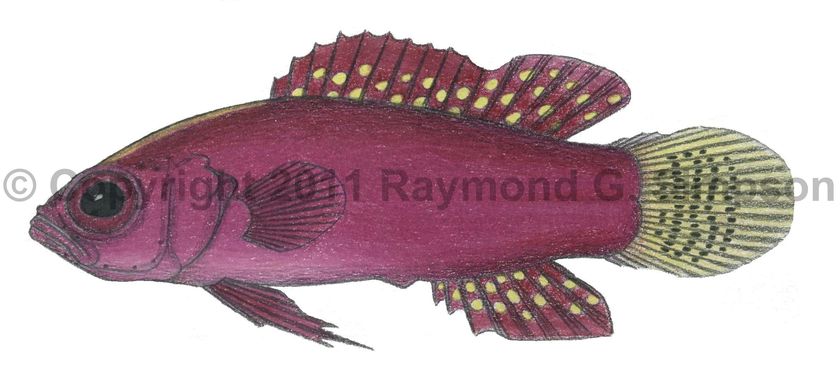
Common Name
Rosy Basslet
Year Described
Robins & Colin, 1979
Identification
Dorsal Fin: XI, 6
Anal Fin: III, 6
Pelvic Fin: I, 5
Pectoral Fin: 16
Caudal Rays (segmented): 19
Gill Rakers:
Vertebrae: 10 precaudal, 15 caudal; 25 total
Lateral Scale Rows: 26
Stout with a pointed snout. Jaw reaches to midpoint of orbit. Lateral line absent. Preopercular margin smooth. Notch between spiny and soft dorsal fin. Outer procurrent caudal rays (3 dorsally and ventrally) thickened. Caudal fin rounded.
Color
Body and head rose colored. A yellow line extends from snout to dorsal origin on nape. Dorsal and anal fins darker rose to red with lighter spots, especially on the soft portions of fins. Caudal fin yellowish with black spots along the segmented rays.
Size
Maximum size to 48mm.
Habitat
Deep water from 32-33m (probably wider depth distribution).
Range
Scattered records in the Caribbean Sea: Bahamas, Colombia, and Puerto Rico.
References
Dennis, G.D., D. Hensley, P.L. Colin and J.J. Kimmel. 2004. New records of marine fishes from the Puerto Rican plateau. Caribb. J. Sci. 40(1):70-87.
Gilmore, R.G. and R.S. Jones. 1988. Lipogramma flavescens, a new grammid fish from the Bahama Islands, with description and distributional notes on L. evides and L. anabantoides. Bulletin of Marine Science v. 42 (no. 3): 435-445.
Gilmore, R.G. 1997. _ Lipogramma robinsi_, a new basslet from the tropical western Atlantic, with descriptive and distributional notes on L. flavescens and L. anabantoides (Perciformes: Grammatidae). Bulletin of Marine Science v. 60 (no. 3): 782-788.
Hardy, J.D. 2005. Chapter 121: Grammatidae, p. 1341-1351. In: Richards, W.J. (Ed.). Early Stages of Atlantic Fishes: An Identification Guide for the Western Central North Atlantic. CRC Press, Boca Raton, Florida.
Mooi, R.D. 2002. Grammatidae. In: FAO Species Identification Guide to Fishes of the Western Atlantic. (ed. Carpenter K), pp. 1308–1369. UN FAO Publishers, Rome.
Robins, C.R. and P.L. Colin. 1979. Three new grammid fishes from the Caribbean Sea. Bulletin of Marine Science v. 29 (no. 1): 41-52.